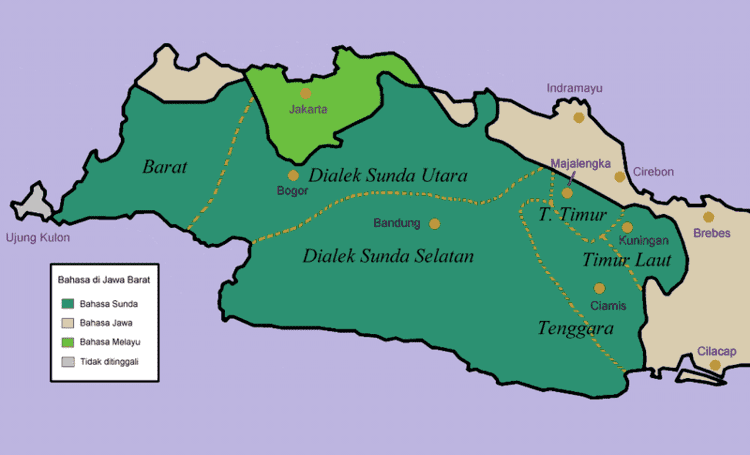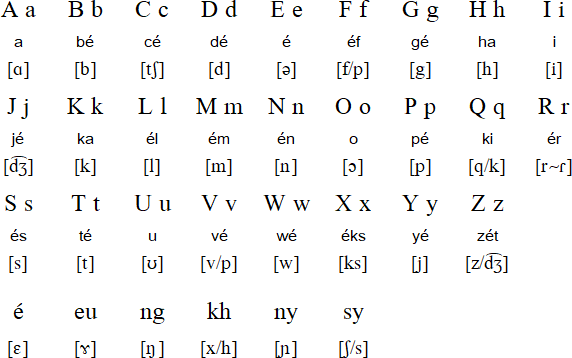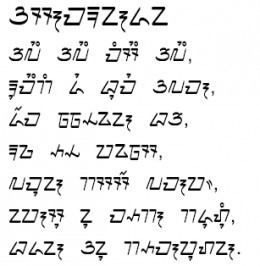ISO 639-1 su | Native speakers 42 million (2016) | |
 | ||
Ethnicity Sundanese, Bantenese, Cirebonese, Badui Writing systems Javanese script (historical), Latin script (present) | ||
Sundanese /sʌndəˈniːz/ (Basa Sunda /basa sʊnda/, in Sundanese script ᮘᮞ ᮞᮥᮔ᮪ᮓ, literally "language of Sunda") is the language of about 39 million people from the western third of Java or about 15% of the Indonesian population.
Contents

Dialects

Sundanese appears to be most Closely related to Madurese and Malay, and more distantly related to Javanese. It has several dialects, conventionally described according to the locations of the people:


Priangan, which covers the largest area of Sunda (Tatar Pasundan in Sundanese), is the most widely spoken type of Sundanese language, taught in elementary till senior-high schools (equivalent to twelfth-year school grade) in West Java and Banten Province.
Writing

Sundanese can be written in different writing systems, the Old Sundanese script (Aksara Sunda Kuno) and Pegon in historical times, and in modern times the Latin script and the modern Sundanese script.
Phonology
Sundanese orthography is highly phonetic (see also Sundanese script). There are seven vowels: a /ɑ/, é /ɛ/, i /i/, o /ɔ/, u /ʊ/, e /ə/, and eu /ɤ/. The consonantal phonemes are transcribed with the letters p, b, t, d, k, g, c (pronounced /tʃ/), j /d͡ʒ/, h, ng (/ŋ/), ny /ɲ/, m, n, s /s/, w, l, r /r~ɾ/, and y /j/. Other consonants that originally appear in Indonesian loanwords are mostly transferred into native consonants: f → p, v → p, sy → s, sh → s, z → j, and kh /x/ → h.
According to Yayat Sudaryat (1991,35) there are 16 consonants in Sundanese phonology: /b/, /tʃ/, /d/, /g/, /h/, /dʒ/, /k/, /l/, /m/, /n/, /p/, /r/, /s/, /ŋ/, /t/; /ɲ/, however, influences from foreign languages have introduced several additional consonants such as /f/, /v/, /z/ (as in fonem, qur'an, xerox, zakat).
There are also /w/ and /j/ as semi vowels, they function as glide sound between two different vowels, as in the words:
Phonemes /w/ and /j/ function as glide sounds between two different vowels as in the words:
Plural form
Other Austronesian languages commonly use reduplication to create plural forms. However, Sundanese inserts the ar infix into the stem word. If the stem word starts with l, or contains r following the infix, the infix ar becomes al. Also, as with other Sundanese infixes (such as um), if the word starts with vowel, the infix becomes a prefix. Examples:
- "Mangga A, tarahuna haneut keneh" (Please sir (offering), the tofus are still warm/hot), The plural form of tahu 'tofu' is formed by infixing ar after the initial consonant.
- "Barudak leutik lalumpatan" (Small children running around), formed from budak (child) with the ar infix and modified to barudak to create plural child (children); in lumpat (run) the ar infix becomes al because lumpat starts with l.
- "Ieu kaen batik aralus sadayana" (All of this batik clothes are beautiful), formed from alus (nice, beautiful, good) with the infix ar that becomes a prefix because alus starts with a vowel. It denotes the adjective "beautiful" for the plural subject/noun (batik clothes).
- "Siswa sakola eta mah balageur" (The students of that school are well-behaved), formed from bageur (good-behaving, nice, polite, helpful) with the infix ar (becomes al because of r in the root) to denote the adjective "well-behaved" for plural students.
However, it is reported that this use of al instead of ar (as illustrated in (4) above) does not to occur if the 'r' is in onset of a neighbouring syllable. For example, the plural form of the adjective curiga (suspicious) is caruriga and not *caluriga, because the 'r' in the root occurs at the start of the following syllable.
The prefix can be repeated twice to denote very-, or the plural of groups. For example, "bararudak" denotes many, many children or many groups of children ("budak" is child in Sundanese). Another example, "balalageur" denotes plural adjective of "very well-behaved".
Active form
Most of active form in Sundanese verb are in their root verb like 'diuk' or 'dahar'. Some other depend on first phonem in root verb:
- first phoneme in 'd' is eliminated and changed to prefix 'nga' like in 'ngadahar'
- first phoneme in 'i' is eliminated and changed to prefix 'ng' like in 'nginum'
- first phoneme in 'b' is eliminated and changed to prefix 'm' like in 'maca'
Negation
"Abdi henteu acan neda". (I have not eaten yet.) Explanation: From the above example, "henteu" is used for negative term. "Buku abdi mah sanes nu ieu". (My book is not this one.) Explanation: From the above example, "sanes" is used for negative term.
Question
Dupi -(question)
example:saya
Polite-
Passive form
"Buku dibantun ku abdi". (The book is brought by me.) Explanation: "dibantun" (to be brought/passive) and "ngabantun" (active) The other examples: "Pulpen ditambut ku abdi". (The pen is borrowed by me.) "Soal ieu digawekeun ku abdi". (This problem is done by me.)
Adjectives
example:
teuas (hard), tiis (cool), hipu (soft), lada (hot, usually for foods), haneut (warm), etc.
